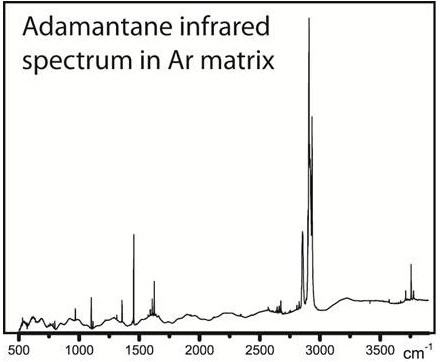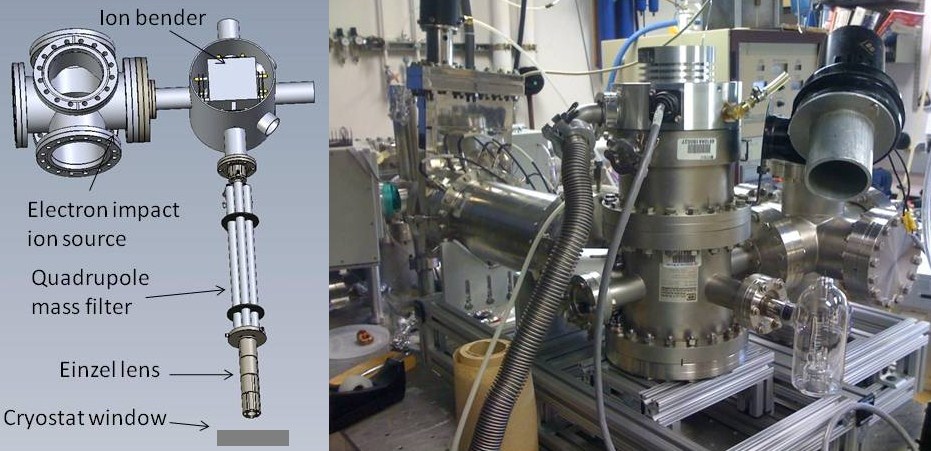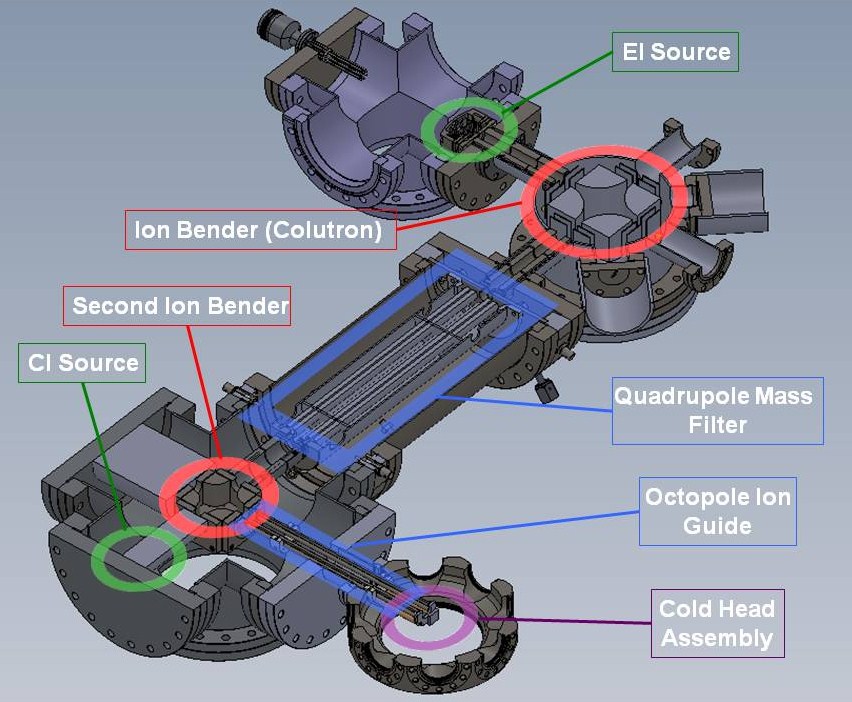AmericanChemicalSociety.com
Reports: DNI6 49572-DNI6: Vibrational and Electronic Spectroscopy of Cationic Diamondoids
Nicolas C. Polfer, PhD, University of Florida
Preliminary Experiments
Preliminary experiments aimed at recording the infrared absorption spectrum of the adamantane radical cation (C10H16+.) in an argon matrix.
Neutral adamantane was deposited into an argon matrix and irradiated with vacuum-ultra-violet Lyman irradiation. Similar approaches for poly-aromatic hydrocarbon (PAH) molecules resulted in cation concentrations of 1-2% relative to the neutrals [1]. The IR spectrum of the cation was then obtained by comparing the infrared absorption spectra of the neutrals with the neutral/cation mixture, in the form of a difference spectrum. Such an approach was found to not to be successful for adamantane, as merely evidence for the neutrals was found (see Fig. 1).

Figure 1. Infrared absorption specrum of adamantane in argon matrix, following Lyman irradiation.
Colutron Ion Deposition Instrument
In a second experiment, a custom-built mass spectrometer (Colutron Research Co.) was employed to generate cations from adamantane by electron impact (EI). For this purpose, a high electron emission EI source was installed, in place of the gas discharge source. High ion emission currents were achieved in this way (~100 nA). Relatively high ion currents were detected at the target (> 1 nA); however, no successful infrared spectra could be recorded. We hypothesize that this failure is due to destruction of the cations upon impact with the surface. Note that the instrumental design required the ions to travel at very high kinetic energies (i.e., keV) through the instrument, in order to achieve high transmission currents. Such a high kinetic energy appears to be incompatible with leaving molecular ions intact.
Custom-Built Ion Deposition Instrument
For this purpose, an entirely different design of a ion deposition instrument has been developed, which allows a relative ‘soft'-landing of the ions. The initial design for this instrument is shown in Fig. 2. The ion source includes the high electron emission current EI source, followed by an ion bender (Colutron Research Co.), a quadrupole mass filter, and an Einzel lens to guide the ions onto the deposition window. This instrument was capable of mass-selectively transmitting 3-4 nA of ion current to the Einzel lens after the quadrupole mass filter, when ions were biased at merely +8 VDC. This means that the ions would impact the matrix surface at a low kinetic energy (i.e., 8 eV), as opposed to 100's-1,000 eV for the previous set-up. Unfortunately, it was found that the ion current deposited on the cryostat window was merely a fraction (~200 pA) of the current collected after the quadrupole mass filter. This suggests that electrostatic focusing of the ions onto the cryostat window was insufficient to overcome the Coulombic repulsion at such high ion currents.

Figure 2. Left: Schematic representation of initial version of custom-built ion deposition instrument, involving EI ion source, ion bender, quadrupole mass filter, Einzel lens and cryostat deposition window. Right: Photograph of instrument.
Further Improvements
In order to overcome these limitations, this set-up is currently being extended (see Fig. 3) to include a number of features that are expected to sharply increase ion transmission:
1. The commercial Colutron ion bender, equipped with shims and narrow slit plates, limited ion transmission in the previous design. The ion losses were measured to be on the order of 200 nA, as opposed to merely 3-4 nA that could be transferred through the quadrupole mass filter. This ion bender has now been modified in our machine shop to increase the openings of the electrodes, and hence reduce ion losses.
2. An octopole ion guide is currently being assembled. This octopole is expected to guide the ions efficiently to the cryostat window, as opposed to the Einzel lens, which resulted in significant ion losses.
3. Another advantage arising from using an octopole ion guide is that positive and negative ions can in principle be transported through this device. We have hence decided to install a second ionization source, a chemical ionization (CI) source, to generate anions. The mass-selected cations from the EI source and the counter-anions (e.g. SF6-), generated in a CI source, are merged into the octopole via a second ion bender (Ardara Technologies, Monroeville, PA). The emission currents from both ion sources will be kept at very similar values, to allow continuous neutralization of the matrix surface with both ion beams.
It is expected that simultaneous deposition of cations and counter-anions will result in substantial enhancements in the density of cations in the matrix. Exclusive deposition of cations quickly builds up charge, which limits further deposition of cations.

Figure 3. Schematic representation of extended version of custom-built ion deposition instrument, involving EI source, ion bender, quadrupole mass filter, second ion bender, CI source, octopole ion guide and cold head assembly for deposition window.
Scientific Meetings
The graduate student on this project, Nathan Roehr, has presented updates on this custom-built instrument at the annual meeting of the American Society for Mass Spectrometry [2].
References
[1] Szczepanski, J.; Vala, M.; Ellinger, Y.; Electronic and vibrational spectra of matrix isolated anthracene radical cations: Experimental and theoretical aspects. J. Chem. Phys. 1993, 98, 4494-4511.
[2] Roehr, N.; Polfer, N.C.; Direct absorption measurements on mass-selected cations trapped in solid argon. 58th American Society for Mass Spectrometry Meeting (Salt Lake City, UT, May 23-27 2010).
Copyright © American Chemical Society

